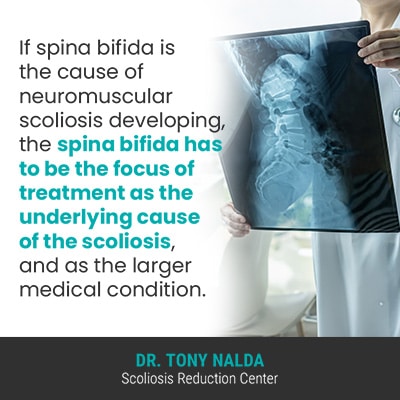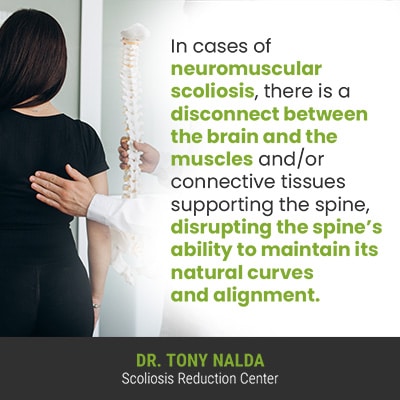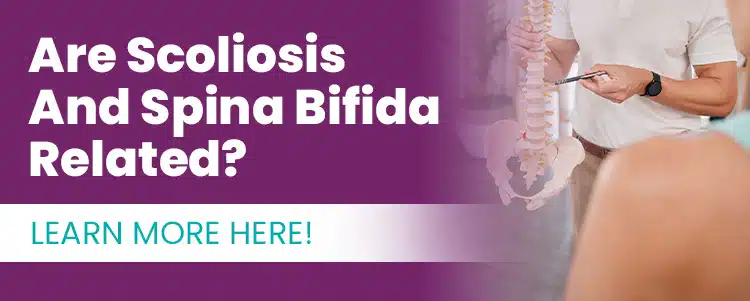There are typical and atypical types of scoliosis, and when we’re talking about neuromuscular scoliosis, this is an atypical form. In typical cases of idiopathic scoliosis, the scoliotic curve bends to the right, away from the heart, but in atypical cases with known causes, the curve can bend to the left, towards the heart; continue reading to understand the difference and the connection between scoliosis and spina bifida.
Scoliosis is an unnatural sideways spinal curve that also twists, and spina bifida is a neuromuscular condition caused by a neural tube defect that develops in utero. It’s estimated that approximately 50 percent of patients with spina bifida will develop neuromuscular scoliosis.
When scoliosis is diagnosed, part of the process involves further classifying conditions based on key patient/condition factors, one of which is condition type.
Diagnosing and Classifying Scoliosis
Scoliosis can be complex to treat not only because it ranges so widely in severity from mild to moderate and severe to very severe, but also because the condition affects all ages, in different ways, and there are multiple different curvature and condition types with unique characteristics and treatment needs.
In order for scoliosis to be diagnosed, an unnatural lateral (side-to-side) curvature of the spine, with a rotational component, has to be present, and in addition, the size of the scoliotic curve has to meet a minimum size requirement: Cobb angle measurement of at least 10 degrees.
A patient’s Cobb angle measurement is a key piece of information that treatment plans are shaped around, and it’s determined during X-ray.
By drawing lines from the tops and bottoms of the curve’s most-tilted vertebrae, at its apex, an intersecting angle is formed that’s expressed in degrees, and the higher the Cobb angle, the more tilted those vertebrae are, and the further out of alignment the spine is.
The higher a patient’s Cobb angle, the more severe the condition, and the more likely it is that the condition’s effects are going to be overt:
- Mild scoliosis: Cobb angle measurement of between 10 and 25 degrees
- Moderate scoliosis: Cobb angle measurement of between 25 and 40 degrees
- Severe scoliosis: Cobb angle measurement of 40+ degrees
- Very-severe scoliosis: Cobb angle measurement of 80+ degrees
So as you can see from the difference in Cobb angle degrees, every case is going to be unique, and as a progressive condition, scoliosis is virtually guaranteed to get worse, so where a patient’s condition is at the time of diagnosis doesn’t mean that’s where it will stay.
Scoliosis is Progressive

As scoliosis progresses, the size of the unnatural spinal curve is increasing, making the spine more rigid and less responsive to treatment, which is why being proactive with treatment is so important.
It’s far more effective to proactively work towards preventing progression and increasing effects than it is to attempt to work towards reversing those effects once they’re established.
In children, the main condition effect is postural deviation, and this involves changes such as uneven shoulders and hips due to the condition’s uneven forces disrupting the body’s overall symmetry; in adults, the main condition effect to worsen with progression is pain as scoliosis becomes a compressive condition once skeletal maturity has been reached.
Now that we’ve explored some important characteristics of scoliosis, let’s now turn our attention to what determines condition type.
Classifying Scoliosis by Type
Condition type is determined by causation, and in approximately 80 percent of known diagnosed scoliosis cases, cause is unknown: idiopathic scoliosis.
In the remaining 20 percent of cases, scoliosis is associated with known causes: congenital scoliosis, degenerative scoliosis, and neuromuscular scoliosis.
Congenital scoliosis is caused by a malformed spine that develops in utero; oftentimes this involves misshapen vertebrae and/or vertebral bodies failing to form into distinct and separate bones, instead becoming fused together as one solid bone.
Degenerative scoliosis affects adults as they age and is caused by natural age-related spinal degeneration, and when it comes to spina bifida, this is associated with neuromuscular scoliosis.
Scoliosis vs Spina Bifida
Scoliosis is a highly-prevalent structural spinal condition that involves a loss of its healthy curves and a rotational component.
The Scoliosis Research Society has current estimates at close to seven million people living with scoliosis in the United States alone, and each year, approximately 14,000 babies are born with spina bifida, so both are prevalent conditions that warrant awareness.
Spina bifida is a neuromuscular condition caused by a neural tube defect that occurs in utero; basically, a baby’s spine and spinal cord don’t develop properly, causing a gap to form in the spine.
Eventually, the neural tube develops into the brain and spinal cord, so a neural tube defect is going to affect the brain and/or spinal cord.
Now, in cases of neuromuscular scoliosis, there is a strong link with spina bifida, so let’s explore that relation.
Are Scoliosis and Spina Bifida Related?

As mentioned, neuromuscular scoliosis has a known cause: the presence of a larger neuromuscular condition such as muscular dystrophy, cerebral palsy, and/or spina bifida can cause scoliosis to develop as a secondary complication.
While having a neuromuscular condition doesn’t guarantee the development of scoliosis, it is a common complication.
In cases of neuromuscular scoliosis, there is a disconnect between the brain and the muscles and/or connective tissues supporting the spine that disrupts the ability to maintain the spine’s natural curves and alignment.
In cases of idiopathic scoliosis, the curve is typical and bends to the right, away from the heart, but in atypical cases, such as neuromuscular scoliosis, the curve bends to the left, towards the heart, and when I see a left-bending curve, this is a red flag that there is an underlying pathology causing the scoliosis.
In these types of cases, it’s the larger neuromuscular condition that has to be the focus of treatment, so if spina bifida is present, it can cause the development of neuromuscular scoliosis.
Neuromuscular Scoliosis
As atypical scoliosis, my neuromuscular scoliosis patients are more complex to treat, so I can’t offer them the same types of prognoses that I can in typical cases of idiopathic scoliosis.
If spina bifida is the cause of neuromuscular scoliosis developing, the spina bifida has to be the focus of treatment as the underlying cause of the scoliosis, and as the larger medical condition.
Neuromuscular patients can become non-ambulatory (unable to walk on their own) and wheelchair bound, and conditions that affect the brain and/or spinal cord can cause a wide range of symptoms felt throughout the body as the brain and spinal cord form the central nervous system.
The central nervous system is a complex and vast communication network that facilitates brain-body communication.
When it comes to progression and severity, neuromuscular scoliosis is shaped by the degree of muscle and nerve involvement.
In general, the more a patient’s spina bifida disrupts movement and balance, the more likely they are to develop scoliosis as a related complication.
Neuromuscular scoliotic curves tend to affect younger children, are long, and affect the entire spine.
Growth will trigger neuromuscular scoliosis progression just as it does in typical cases of idiopathic scoliosis.
Conclusion
The neural tube is the structure that develops into a baby’s spine and brain, and spina bifida involves a neural tube defect as the tube doesn’t close properly, causing some of the bones in the spine to also not close properly.
Scoliosis involves the development of an unnatural sideways spinal curve, and a scoliotic curve doesn’t just bend unnaturally to the side, it also twists from front to back, back to front.
The spine’s healthy curves make it stronger, more flexible, and better able to handle mechanical stress incurred during activity, but it’s not just the spine that has to maintain its natural curves and alignment; it’s also the responsibility of the spine’s surrounding muscles to support and stabilize it.
Neuromuscular conditions affect the brain, the spine, and muscles surrounding the spine, so they can cause the development of an unnatural scoliotic curve.
Neuromuscular scoliosis caused by spina bifida is progressive and tends to be severe because of the underlying neuromuscular condition, and in these types of cases, it’s the spina bifida that’s going to be the focus of treatment.
While neuromuscular scoliosis cases are more complex to treat, condition improvement can be worked towards, and here at the Scoliosis Reduction Center®, I’ve treated all types of scoliosis, neuromuscular scoliosis included.
Approximately 50 percent of people with spina bifida will also develop scoliosis, so they are related in terms of causation, and also as conditions that affect the brain and spinal cord.




